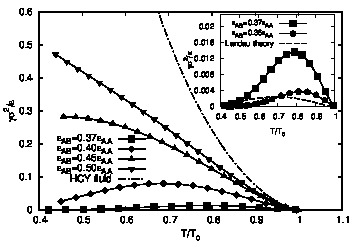Research Investigação
Patchy colloids are hard spherical particles decorated with discrete attractive sites (“patches”) on their surfaces [1]. They provide a conceptually simple model for systems in which strongly anisotropic interactions play an important role, and as such allow detailed theoretical and computational studies of the interplay between phase separation and self-aggregation, including physical gelation. A natural generalization of the model is to allow patches to be of different types. This was first introduced by Wertheim in the context of his first-order thermodynamic perturbation theory of association (TPT1) [2]. The special case of two types of patches (A and B) was extensively studied by our group using TPT1 (see, e.g., [3]). In particular, it was found that, when AB bonds (“Y junctions”) dominate, the liquid-vapour binodal is reentrant and very low density liquids can form, not only close to the critical point, but also at much lower temperatures: These liquid states consist of long chains of AA-bonded particles, occasionally branching at AB bonds. One logical next step is to look at the interfacial properties of this model. We are currently using the density-functional theory (DFT) form of TPT1 [4] to calculate the density and degree of association profiles of 2AnB patchy colloids in several different experimental geometries. Our first set of results is for the liquid-vapour interface [5]. In reentrant systems,, an unusual thickening of the interface is observed at low temperatures. Furthermore, the surface tension versus temperature curve reaches a maximum, in agreement with Bernardino and Telo da Gama’s mesoscopic Landau-Safran theory [6]. If BB attractions are also present, competition between AB and BB bonds gradually restores the monotonic temperature dependence of the surface tension and the system reverts to the behaviour seen in atomic fluids.. Lastly, the interface is “hairy,” i.e., it contains a region where the average chain length is close to that in the bulk liquid, but where the density is that of the vapour. Work is now underway to extend the theory to solid-fluid interfaces.

Figure caption: non-monotonic surface tension vs temperature curves for re-entrant phase diagrams of 2A9B patchy colloids. HCY is the result for a hard-core Yukawa fluid. The inset compares our results (lines with symbols) with Bernardino and Telo da Gama's (dashed line).
References
[1] M. S. Wertheim, J. Stat. Phys. 35, 19 (1984).
[2] M. S. Wertheim, J. Stat. Phys. 42, 459 (1986).
[3] J. M. Tavares and P. I. C. Teixeira, J. Phys.: Condens. Matter 24, 284108 (2012).
[4] Y.-X. Yu and J. Wu, J. Chem. Phys. 116, 7094 (2002).
[5] A. Oleksy and P. I. C. Teixeira, Physical Review E 91, 012301 (2015). http://journals.aps.org/pre/abstract/10.1103/PhysRevE.91.012301
[6] N. R. Bernardino and M. M. Telo da Gama, Phys. Rev. Lett. 109, 116103 (2012).
